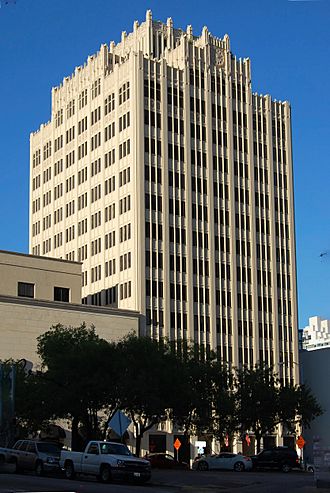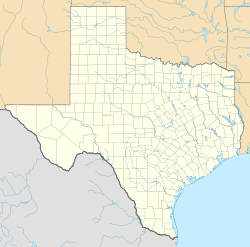Norwood Tower facts for kids
Quick facts for kids Norwood Tower |
|
|---|---|

Viewed from the southwest, with the Motoramp Garage to the lower left
|
|
| Former names | Capital National Bank Building |
| General information | |
| Architectural style | Gothic Revival |
| Location | 114 West 7th Street Austin, Texas 78701 |
| Named for | Ollie Osborn Norwood |
| Groundbreaking | 1928 |
| Opened | 1929 |
| Renovated | 1982–3 |
| Cost | $750,000 |
| Renovation cost | $5,000,000 |
| Height | 189 feet (58 m) |
| Technical details | |
| Floor count | 16 |
| Floor area | 121,430 square feet (11,281 m2) |
| Lifts/elevators | 3 |
| Design and construction | |
| Architect | Bertram Giesecke, August Watkins "Watt" Harris |
| Main contractor | Frank Barron |
| Renovating team | |
| Architect | Ford, Powell & Carson |
|
Norwood Building
|
|
| NRHP reference No. | 10001224 |
| Significant dates | |
| Added to NRHP | February 7, 2011 |
The Norwood Tower is a historic building in downtown Austin, Texas. It was once called the Capital National Bank Building. This tower was built in 1929.
It was named a Recorded Texas Historic Landmark in 2006. In 2011, it was added to the National Register of Historic Places. When it was first built, it was the tallest commercial building in Austin. It was also the first office building in Austin with full air conditioning. The parking garage next to it was the city's first self-parking garage with ramps. The Norwood Tower is still Austin's only Gothic Revival style high-rise building.
Contents
History of the Norwood Tower
In the early 1920s, a businessman from Austin, Texas named Ollie Osborn Norwood wanted to build a big new office tower. He saw that Austin was growing and needed more office space. At that time, Austin only had a few tall commercial buildings.
Norwood planned a very modern building. It would have air conditioning in every office, which was new for Austin. It would also have its own parking garage. In 1925, he bought land downtown. He first built the parking garage, which he called the "Motoramp Garage." It cost $250,000 (equivalent to $4,200,000 in 2022). This garage was the first multi-story garage in Austin where drivers could park their own cars using ramps.
The garage was finished in January 1928. Then, Norwood tore down an old house on the land. He started building the office tower. The tower cost $750,000 (equivalent to $12,800,000 in 2022). Construction was completed in the summer of 1929. The Norwood Building then became home to doctors, lawyers, financial companies, shops, and government offices. At that time, it was the tallest commercial building in the city. It was the third tallest structure overall, after the Texas State Capitol and the Stephen F. Austin Hotel.
The Capital National Bank Building Era
In January 1934, the Capital National Bank of Austin moved into the first floor of the Norwood Building. In 1944, the bank bought the building. They changed its name to the "Capital National Bank Building."
In 1951, the bank changed the garage next door. This allowed them to expand their banking services into the garage building. Over many years, the bank used more and more of the building. Finally, in 1981, the bank moved its main office to a larger building.
The Norwood Tower Today
After the bank moved in 1981, new owners took over the building. They changed the building's name to the "Norwood Tower." They did major repairs and updates between 1982 and 1983. These renovations cost $5 million (equivalent to $15,200,000 in 2022).
During this time, the outside of the tower and its lobby were fixed and restored. The building was also updated to meet modern safety rules. The tower was recognized as a Recorded Texas Historic Landmark in 2006. On February 7, 2011, it was added to the National Register of Historic Places.
Clarence Odie Williams' Important Role
From when the building opened in 1929 until 1964, Clarence Odie Williams was the Norwood Tower's maintenance engineer. He was an African-American man from Austin. Williams had his own private office in the tower. This office had its own restroom. He made this restroom available for public use.
During the time of segregation, before the Civil Rights Act of 1964 was passed, Williams's office was very important. It was the only public restroom in downtown Austin that was open to "colored" people. African Americans who were in downtown Austin for business often visited his office.
Architecture and Design
The Norwood Tower is a sixteen-story building. It has a steel frame and is covered with precast concrete panels. Its design shows the Gothic Revival style, sometimes called "Commercial Gothic." This style was popular for tall buildings in Texas in the 1920s.
You can see this style in its straight vertical lines, fancy stone patterns called tracery, pointed roof tops called pinnacles, and decorative gargoyles. The Norwood Tower is the only tall building in Austin built in this Gothic Revival style. Local architects Bertram Giesecke and August Watkins "Watt" Harris designed the building. Frank Barron was the main builder.
The first thirteen floors of the tower are for businesses and offices. The fourteenth and fifteenth floors are a two-story penthouse apartment. This apartment has small gardens on the corners of the roof. The sixteenth floor is a mechanical level. This floor holds the building's elevator machines and other equipment.
Exterior Details
The tower starts with a square base and stays square for the first thirteen stories. Above the thirteenth floor, the corners are set back. This makes the penthouse on the fourteenth and fifteenth floors shaped like a cross. Above the fifteenth floor, the sides are also set back. This makes the sixteenth floor a narrower rectangle. The garage next to the tower covers the bottom five stories on the north and west sides.
The main entrance is on the south side. It has seven arched openings at ground level. The middle three arches have entrance doors. The other four arches have windows. Square columns, called piers, separate these seven sections. These columns continue upwards as pilasters, running vertically up the tower's face. Between these pilasters, thin vertical lines divide each section into three parts. Each part has a narrow vertical window on every floor.
The panels between the first and second floors are decorated with carved patterns. These patterns look like plants. The panels between the second and third floors have a band of open, four-leaf clover shapes called quatrefoils. Above these, there is a row of twenty-seven small gargoyles. These gargoyles are at the level of the third-story windows. The panels between the twelfth and thirteenth floors have carvings of the Scales of Justice and the Caduceus. These symbols represent the legal and medical professionals who were the first people to rent offices in the tower.
At the very top of the middle section, just below the roof, there is a large clock. It no longer works. Its face looks like a rose window, which is a round, decorative window. Panels with carved patterns surround it. At the different roof lines, created by the setbacks, the columns and lines end in fancy decorations called finials and more gargoyles. These details give the tower a complex and pointed outline against the sky. The other sides of the building look similar to the south side, but they do not have the arched entrance, the lower gargoyles, or the clock face.



